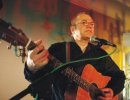Bossa Nova
Users contributing to this page: JanMalysiak
Bossa nova (Portuguese pronunciation: [ˈbɔsɐ ˈnɔvɐ]) is a style of samba developed in the late 1950s and early 1960s in Rio de Janeiro, Brazil. It is mainly characterized by "different beat" that altered the harmonies with the introduction of unconventional chords and an innovative syncopation of traditional samba from a single rhythmic division. Therefore, the "bossa nova beat", then, is characteristic of a samba style and not of an autonomous genre.
According to the Brazilian journalist Ruy Castro, the bossa beat – which would be created by the drummer Milton Banana – was "an extreme simplification of the beat of the samba school", as if all instruments had been removed and only the tamborim had been preserved. In line with this thesis, musicians such as Baden Powell, Roberto Menescal and Ronaldo Bôscoli, also claim that this beat is related to the tamborim of the samba school. One of the major innovations of bossa nova was the way to synthesize the rhythm of samba on the classical guitar. According to musicologist Gilberto Mendes, the bossa nova was one of the "three rhythmic phases of samba", in which the "bossa beat" had been extracted by João Gilberto from the traditional samba. According to the author Walter Garcia, the synthesis performed by Gilberto's guitar was a reduction of the "batucada" of samba, a stylization produced from one of the percussion instruments: the thumb stylized a surdo; the index, middle and ring fingers phrased like a tamborim.
The bossa nova wave came to renew samba and to contribute to the modernization of Brazilian music, being a watershed. The style emerged at the time when samba-canção was the dominant rhythm in the Brazilian music scene. Its first appearance was on the album Canção do Amor Demais, in which the singer Elizeth Cardoso recorded two specifically compositions by the duo Antônio Carlos Jobim and Vinicius de Moraes, "Outra Vez" and "Chega de Saudade", which were accompanied by João Gilberto's guitar. It was the first time that the Bahian musician presented the beat of his guitar that would become characteristic of the style. By accompanying Cardoso's voice, Gilberto innovated in the way of pacing the rhythm, accentuating the weak times, in order to carry out a synthesis of the beat of samba to guitar.
Months later, João Gilberto's first album was released, containing the tracks "Chega de Saudade" and "Bim Bom". Considered the landmark of the birth of bossa nova, it also featured Gilberto's innovative way of singing samba, which was inspired by Dorival Caymmi. With the LP Chega de Saudade, released in 1959, Gilberto consolidated the bossa nova as a new style of playing samba. His innovative way of playing and singing samba, combined with the harmonies of Antônio Carlos Jobim and the lyrics of Vinicius de Moraes, found immediate resonance among musicians who were looking for new approaches to samba in Rio de Janeiro, many of them were influenced by American jazz. Then, it emerged an artistic movement around Gilberto and others professional artists such as Jobim, Moraes and Baden Powell, among others, which attracted young amateur musicians from the South Zone of Rio – such as Carlos Lyra, Roberto Menescal, Ronaldo Bôscoli and Nara Leão.
-
Nasza Basia Kochana
-
 Poland
Poland
- 1975-present
-
-
João Gilberto
-
 Brazil
Brazil
- 1950-2019
-
-
Jerzy Filar
-
 Poland
Poland
- 1973-present
-
-
Antônio Carlos Jobim
-
 Brazil
Brazil
- 1945-1994
-
-
Astrud Gilberto
-
 Brazil
Brazil
- 1963-2002
-





